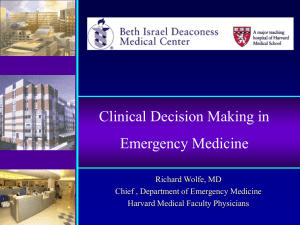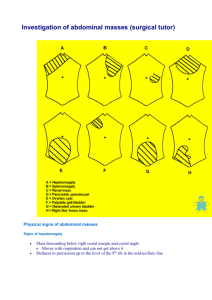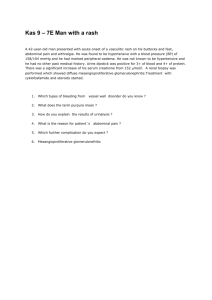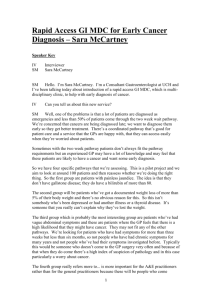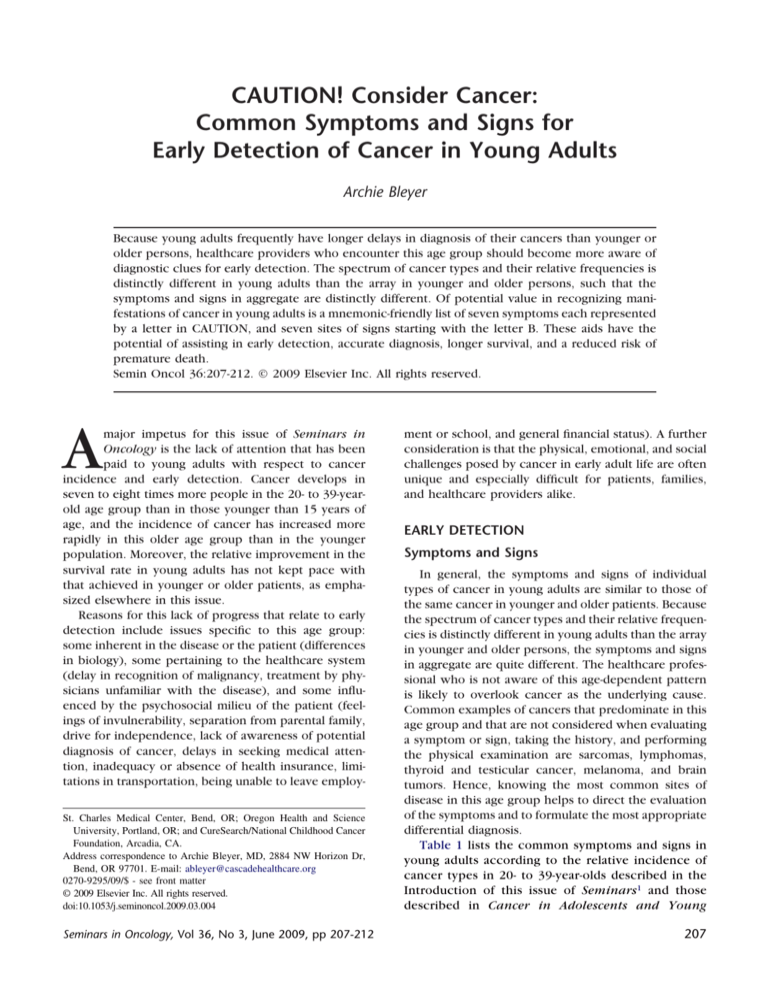
CAUTION! Consider Cancer:
Common Symptoms and Signs for
Early Detection of Cancer in Young Adults
Archie Bleyer
Because young adults frequently have longer delays in diagnosis of their cancers than younger or
older persons, healthcare providers who encounter this age group should become more aware of
diagnostic clues for early detection. The spectrum of cancer types and their relative frequencies is
distinctly different in young adults than the array in younger and older persons, such that the
symptoms and signs in aggregate are distinctly different. Of potential value in recognizing manifestations of cancer in young adults is a mnemonic-friendly list of seven symptoms each represented
by a letter in CAUTION, and seven sites of signs starting with the letter B. These aids have the
potential of assisting in early detection, accurate diagnosis, longer survival, and a reduced risk of
premature death.
Semin Oncol 36:207-212. © 2009 Elsevier Inc. All rights reserved.
A
major impetus for this issue of Seminars in
Oncology is the lack of attention that has been
paid to young adults with respect to cancer
incidence and early detection. Cancer develops in
seven to eight times more people in the 20- to 39-yearold age group than in those younger than 15 years of
age, and the incidence of cancer has increased more
rapidly in this older age group than in the younger
population. Moreover, the relative improvement in the
survival rate in young adults has not kept pace with
that achieved in younger or older patients, as emphasized elsewhere in this issue.
Reasons for this lack of progress that relate to early
detection include issues specific to this age group:
some inherent in the disease or the patient (differences
in biology), some pertaining to the healthcare system
(delay in recognition of malignancy, treatment by physicians unfamiliar with the disease), and some influenced by the psychosocial milieu of the patient (feelings of invulnerability, separation from parental family,
drive for independence, lack of awareness of potential
diagnosis of cancer, delays in seeking medical attention, inadequacy or absence of health insurance, limitations in transportation, being unable to leave employSt. Charles Medical Center, Bend, OR; Oregon Health and Science
University, Portland, OR; and CureSearch/National Childhood Cancer
Foundation, Arcadia, CA.
Address correspondence to Archie Bleyer, MD, 2884 NW Horizon Dr,
Bend, OR 97701. E-mail: ableyer@cascadehealthcare.org
0270-9295/09/$ - see front matter
© 2009 Elsevier Inc. All rights reserved.
doi:10.1053/j.seminoncol.2009.03.004
Seminars in Oncology, Vol 36, No 3, June 2009, pp 207-212
ment or school, and general financial status). A further
consideration is that the physical, emotional, and social
challenges posed by cancer in early adult life are often
unique and especially difficult for patients, families,
and healthcare providers alike.
EARLY DETECTION
Symptoms and Signs
In general, the symptoms and signs of individual
types of cancer in young adults are similar to those of
the same cancer in younger and older patients. Because
the spectrum of cancer types and their relative frequencies is distinctly different in young adults than the array
in younger and older persons, the symptoms and signs
in aggregate are quite different. The healthcare professional who is not aware of this age-dependent pattern
is likely to overlook cancer as the underlying cause.
Common examples of cancers that predominate in this
age group and that are not considered when evaluating
a symptom or sign, taking the history, and performing
the physical examination are sarcomas, lymphomas,
thyroid and testicular cancer, melanoma, and brain
tumors. Hence, knowing the most common sites of
disease in this age group helps to direct the evaluation
of the symptoms and to formulate the most appropriate
differential diagnosis.
Table 1 lists the common symptoms and signs in
young adults according to the relative incidence of
cancer types in 20- to 39-year-olds described in the
Introduction of this issue of Seminars1 and those
described in Cancer in Adolescents and Young
207
208
Table 1. Common Symptoms and Signs of Cancer in Young Adults
Cancer*
Symptoms
Breast cancer
Melanoma
Breast lump, discharge from nipple
Increasing size, color change, bleeding, itching of skin lesion
Thyroid cancer
Testis cancer
Non-Hodgkin
lymphoma
Uterine cervix cancer
Lump in neck, hoarseness, cough, difficulty in swallowing
Painless lump in testicle
Fever, night sweats, weight loss, enlarged lymph node(s)
Hodgkin lymphoma
Colorectal cancer
Fever, night sweats, weight loss, enlarged lymph node(s)
Abdominal pain, weight loss, vomiting, constipation, diarrhea, loss
of appetite rectal bleeding, abdominal distension
Headache, vomiting, deterioration in intellectual capacity, alteration
in mood, limb weakness, bladder and bowel disturbance, seizures
CNS tumors
Soft-tissue sarcomas
Oral cavity and
pharynx cancer
Lung cancer
Kidney cancer
Endometrial cancer
Ovarian tumors
Acute myelogenous
leukemia
Stomach cancer
Bladder cancer
Acute lymphoblastic
leukemia
Bone sarcomas
Liver cancer
Abnormal vaginal discharge
Signs
Breast mass, nipple discharge, skin change (peau d’ orange)
Increasing size, irregularity of shape, color change, ulceration or
bleeding of skin lesion
Hard, irregular mass in neck
Firm testicular mass
Adenopathy, mediastinal obstruction, abdominalmass,
hepatomegaly, splenomegaly, inflammatory skin infiltrates
Palpable pelvic, abdominal or rectal mass; abnormal vaginal
examination
Adenopathy, mediastinal onstruction, hepatomegaly, splenomegaly
Palpable abdominal, pelvic or rectal mass
Enlarging painless lump
Mouth sore or bleeding, difficulty in swallowing neck swelling
Gait disturbance, loss of coordination, nystagmus, proptosis,
dysconjugate eye movements, cranial nerve palsies, dysarthria,
deafness, limb weakness
Palpable mass, proptosis, cranial nerve palsy, or nasal obstruction
Mouth or oropharynx lesion, palpable neck mass
Cough, abnormal (especially blood-tinged) sputum
Blood in urine, back or pelvic pain
Pelvic pain, abnormal vaginal discharge or menstruation
Abdominal pain, increasing abdominal girth
Fever, fatigue, abnormal bleeding, pallor
Rales, mediastinal obstruction
Hematuria, abnormal urethral discharge, abdominal or pelvic mass
Palpable abdominal or pelvic mass
Palpable abdominal mass, abnormal vaginal discharge
Petechiae, purpura, mucosal bleeding, hepatomegaly, splenomegaly
Abdominal pain, weight loss, diminished appetite, nausea, vomiting
Lower abdominal pain, blood in urine
Pallor, fatigue, fever, bone pain
Palpable abdominal mass
Palpable abdominal or pelvic mass
Hepatomegaly, splenomegaly, petechiae, purpura, mucosal
bleeding, palpable lymphadenopathy
Joint swelling, palpable mass
Pain, limping, swelling, non-resolution of prior athletic injury or
other physical trauma, unusual limitation of daily activities
Abdominal enlargement, loss of appetite, weight loss, abdominal
pain, jaundice
Hepatomegaly, jaundice, splenomegaly, spider angiomata, ascites,
pallor
Compiled in part from Cancer in Adolescents and Young Adults, 2007, Chapters 6-20.2
*In order of frequency in 20- to 39-year-olds, US Surveillance, Epidemiology and End Results (SEER) 2000-2004, with females and males combined.
A. Bleyer
CAUTION! Consider cancer
209
Unilateral knee/shoulder pain/swelling
Change in mole or new skin lesions
PJ Buecker, MC Gebhardt, K Weber: Osteosarcoma. Liddy Schriver Sarcoma Initiative
Figure 3. Seven symptoms of cancer in young adults:
CA UTION! Consider Cancer.
Figure 1. Seven symptoms of cancer in young adults:
CAUTION! Consider Cancer.
Adults, ed. 2007.2 This list can be collapsed into
seven major symptom groups (Figures 1-7), seven
major sites on physical examination of signs of cancer (Figure 8), and seven orifices of abnormal discharge that may signify cancer (Figure 9). As a mnemonic guide, the latter can each be identified with a
word that starts with the letter B, and each major
symptom can be identified by a letter in the expletive
of “CAUTION! Consider Cancer.”
Radiologic and Pathologic Considerations
Knowing the most common sites and histology of
malignancies in young adults also can assist the physician
in knowing what types of diagnostic imaging to order and
can help radiologists to interpret them and advise on
alternative or additional examinations. Positron emission
tomography (PET scans) and selective radionuclide scans
(eg, thyroid and bone scans) may be particularly helpful
in evaluating symptoms in the young adult and in selecting the most appropriate biopsy procedures. Non-inva-
Abnormal discharge from orifice
sive imaging without the need for sedation, endoscopy,
and minimally invasive surgery are all available for patients in this age group. It also is possible that diagnostic
imaging is underused in this group, in comparison with
younger and older patients, because of a lack of health
insurance and other economic constraints, difficulty taking time off from work, transportation limitations, and a
lack of understanding on the part of healthcare professionals as to what diagnostic and staging procedures are
appropriate. The opposite tendency of ordering an excessive number of or inappropriate studies is likely in the age
group given the under-appreciation of cancer risk in
young adults, the kinds of cancer that do occur, less
certainty of follow-through by the patient, and a heightened sense of the possibility of litigation.
DIAGNOSTIC DELAY
Because of psychological and social issues in young
adults, patients in this age range may be at higher risk
for a delay in diagnosis, a factor that may impact their
survival. In a study of the interval between symptom
onset and diagnosis in 2,665 children participating in
Pediatric Oncology Group therapeutic protocols between 1982 and 1988, Pollock and colleagues found by
multivariate analysis that, for all solid tumors except
Hodgkin lymphoma, as age increased, lag time increased.3 Data on 15- to 29-year-olds with newly diagnosed, previously untreated cancer seen at the University of Texas M.D. Anderson Cancer Center indicate
Tumor / bulge/ bump / lump anywhere
Figure 2. Seven symptoms of cancer in young adults:
C AUTION! Consider Cancer.
Figure 4. Seven symptoms of cancer in young adults:
CAU T ION! Consider Cancer.
210
A. Bleyer
Increasing lymph gland
Neurologic deficit
Figure 5. Seven symptoms of cancer in young adults:
CAUT ION! Consider Cancer.
Figure 7. Seven symptoms of cancer in young adults:
CAUTIO N! Consider Cancer.
that, in this age group, the lag time to diagnosis was
correlated with the quality of health insurance. Those
with public or no health insurance had longer lag
times, ranging from weeks to months, in all of the types
of cancers evaluated except Hodgkin lymphoma.
Those with statistically significantly longer lag times
included patients with acute lymphoblastic leukemia,
acute myelogenous leukemia, diffuse large-cell lymphoma, and osteosarcoma.4,5 Non-statistically significant longer lag times were observed in young adults
with gliomas, follicular thyroid cancer, and melanoma.
In multivariate analysis, only the type of cancer and
quality of health insurance were correlated significantly
with lag time. Gender, age subgroup, race/ethnicity,
religion, marital status, rural versus urban residence,
and median household income and population density
of the zipcode of residence were not correlated with
lag time. The contribution of health insurance may be
lessened in countries with universal health care coverage, but not eliminated, since the quality of national
health services and their utilization by young adults are
suboptimal in this age group.
The reasons for delay in seeking medical care and
obtaining a diagnosis are multiple:
Obstinate fatigue, fever
●
Young adults have a strong sense of invincibility
and invulnerability. Out of denial, they may delay
seeing a physician for symptoms. And when a
symptom is admitted, it is more often at this age
than at any other regarded as psychosomatic, as
interpreted by the person (“it must be in my
head”) or expressed by friends (“get over it”). Even
when seen, the young adult may give poor historical information, especially to a physician untrained to “read between the lines” of a young
adult’s history. Some of the most advanced disease
presentations occur in patients in their early 20s.
Masses of the breast, testis, abdomen, pelvis, and
extremity may be harbored for months because of
embarrassment or uncertainty as to whether to
bring the problem to anyone’s attention.
Brain
Breast
Belly
Balls
Bone
Blood
Bare
(Birth Canal)
Figure 6. Seven symptoms of cancer in young adults:
CAUTI ON! Consider Cancer.
Figure 8. Seven signs of cancer in young adults.
CAUTION! Consider cancer
Figure 9. Seven sites (signs) of abnormal discharge from
orifices as signs of cancer in young adults.
●
●
●
●
Young adults aren’t “supposed to” have cancer.
Clinical suspicion is low, and symptoms are often
attributed to physical exertion, fatigue, stress, or
other psychosomatic explanations, as described
above.
Too many young adults do not receive routine
medical care. Regardless of health insurance status, young adults are more likely than younger or
older patients to lack a usual source of care. Without a primary physician who knows the patient’s
baseline heath status, the symptoms of cancer can
be missed.
Young adults are the most under-insured age
group, at least in the United States, falling in the
gap between parental coverage and programs designed to provide universal health insurance to
children (Medicaid and Children’s Health Insurance Programs), and the coverage supplied by a
full-time secure job with an employer who provides health insurance. In the United States, the
highest rate of un-insurance occurs in 19- to 24year-olds, at 33.6% not insured for a whole year,
followed by 25- to 34-year-olds at 26.1%.6 Underinsured rates (insured for part of a year or insured
with plans that provide minimal coverage) are
even higher and probably exceed half of young
adult Americans.7-10
The evaluating medical professional may be poorly
trained or unwilling to care for young adults.
Given the lack of routine care, empowering young
adults for self-care and early detection of disease is important. Certainly, self-examination of the skin should be
211
encouraged. Self-breast and self-testicular examination,
which historically had been recommended, are no longer
considered to be of sufficient value, relative to rates of
excessive diagnostic evaluations and anxiety on the part
of the person, family, and even the healthcare providers,
to recommend their routine application.11-13 Also, it may
be difficult to teach the importance of early detection of
cancer to young adults, because at no other time in life is
the sense of invincibility more pervasive. And for breasts
and testes, education of young adults may be somewhat
difficult to bring up and teach at this age. On the other
hand, teaching testicular cancer awareness to high school
and college students may not be as difficult as it may
seem. A preliminary assessment of teaching testicular selfexaminations showed that anxiety was no greater in students who were exposed to presentations on testicular
cancer and testicular self-examination than in those who
did not receive this training.14 Additionally, efforts should
be made to educate young adults about the treatment and
high cure rates of early cancer in this age group in order
to dispel the fatalistic perception that arises from knowing older individuals (grandparents, parents, uncles,
aunts, others) who have died from cancer.
CONCLUSIONS AND RECOMMENDATIONS
Given the many factors that lead to delays in seeking
medical attention, including a sense of invincibility,
lack of awareness of personal cancer risk, lack of health
insurance, reluctance to leave school or work, general
underutilization of medical services, and unreliability of
keeping follow-up appointments, there is a greater
need to consider cancer at the earliest possible encounter in a young adult than in younger or older patients.
That delays and lack of compliance are greater in young
adults than at any other age may help explain the
relative lack of progress in survival prolongation and
mortality reduction in young adults with cancer.
Since the array of cancers in young adults is unique—
there is no other age which has a similar distribution—the
symptoms and signs differ from other age groups. It is
helpful to know the most common cancers in the age
group, and their common symptoms and signs in aggregate. Of potential value in recognizing manifestations of
cancer in young adults is a mnemonic-friendly list of seven
symptoms each represented by a letter in CAUTION, and
seven sites of signs starting with the letter B. These aids
should be considered by all practitioners who encounter
young adults for medical evaluation, whether physicians,
nurses, psychologists, chiropractors, or allied health professionals. They have the potential of assisting in early
detection, accurate diagnosis, longer survival and a reduced risk of premature death.
REFERENCES
1. Bleyer A, Barr R. Cancer in young adults 20 to 39 years of
age: overview. Semin Oncol. 2009;36:194-206.
212
2. Bleyer A, Barr RD, Albritton KH, Phillips M, Siegel S,
editors. Cancer in adolescents and young adults. New
York: Springer Verlag; 2007.
3. Pollock BH, Krischer JP, Vietti TJ. Interval between
symptom onset and diagnosis of pediatric solid tumors.
J Pediatr. 1991;119:725-32.
4. Bleyer A, Ulrich C, Martin S, Munsell M, Lange G, Taylor
S. Status of health insurance predicts time from symptom
onset to cancer diagnosis in young adults [abstract]. Proc
Am Soc Clin Oncol. 2005;23 Suppl:547s.
5. Martin S, Ulrich C, Munsell M, Lange G, Taylor S, Bleyer
A. Time to cancer diagnosis in young Americans depends
on type of cancer and health insurance status. Value
Health. 2005;8:344.
6. Steinbrook R. Health care reform in Massachusetts—a
work in progress. N Engl J Med. 2006;354:2095-8.
7. Robert Wood Johnson Foundation, 2003; Report by Families USA & The Lewin Group.
8. General Accounting Office. Analysis of March 2000 cur-
A. Bleyer
9.
10.
11.
12.
13.
14.
rent population survey of nonelderly ⬍65 years, and of
young adult, 18-24 year olds, Washington, DC.
Fishman E. Aging out of coverage: young adults with
special health needs. Health Affairs. 2001;20.6:254-66.
White PH. Access to health care: health insurance considerations for young adults with special health care
needs/disabilities. Pediatrics. 2002;110:1328-35.
U.S. Preventive Services Task Force, http://www.ahrq.
gov/clinic/uspstf/uspsbrca.htm; accessed October 12,
2008.
Howard F, Scott-Findlay S. Breast self-examination: when
research contradicts accepted practice. AWHONN Lifelines. 2006;10:66-70.
U.S. Preventive Services Task Force, http://www.ahrq.
gov/clinic/uspstf/uspstest.htm; accessed October 12,
2008.
Friman PC, Finney JW, Glasscock SG, et al. Testicular selfexamination: validation of a training strategy for early cancer detection. J Appl Behav Anal. 1986;19:87-92.


